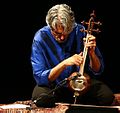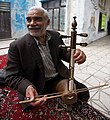The kamancheh (also kamānche or kamāncha) (Persian: کمانچه, Azerbaijani: kamança, Armenian: քամանչա, Kurdish: کەمانچە ,kemançe) is an Iranian bowed string instrument used in Persian,[1] Azerbaijani,[2] Armenian,[3] Kurdish,[4] Georgian, Turkmen, and Uzbek music with slight variations in the structure of the instrument.[5][6] The kamancheh is related to the rebab which is the historical ancestor of the kamancheh and the bowed Byzantine lyra.[7] The strings are played with a variable-tension bow.
 Persian Kamānches, ca. 1880 | |
| String instrument | |
|---|---|
| Other names | Kamancha, Kamanche, Kemancheh, Kamanjah, Kabak kemane |
| Classification | Bowed strings |
| Developed | Iran |
| Playing range | |
| g3-e7 | |
| Related instruments | |
| Musicians | |
| Builders | |
| |
| Sound sample | |
| Art of crafting and playing with Kamantcheh/Kamancha, a bowed string musical instrument | |
|---|---|
| Country | Azerbaijan and Iran |
| Reference | 01286 |
| Inscription history | |
| Inscription | 2017 (13th session) |
| List | Representative |

In 2017, the art of crafting and playing with Kamantcheh/Kamancha was included into the UNESCO Intangible Cultural Heritage Lists of Azerbaijan and Iran.[8]
Name and etymology
The word "kamancheh" means "little bow" in Persian (kæman, bow, and -cheh, diminutive).[9] The Turkish word kemençe is borrowed from Persian, with the pronunciation adapted to Turkish phonology. It also denotes a bowed string instrument, but the Turkish version differs significantly in structure and sound from the Persian kamancheh. There is also an instrument called kabak kemane literally "pumpkin-shaped bow instrument" used in Turkish music which is only slightly different from the Iranian kamancheh.[10]
Structure
The kamancheh has a long neck including fingerboard which kamancheh maker shapes it as a truncated inverse cone for easy bow moving in down section, pegbox in both side of which four pegs are placed, and finial[11] Traditionally kamanchehs had three silk strings, but modern instruments have four metal strings. Kamanchehs may have highly ornate inlays and elaborately carved ivory tuning pegs. The body has a long upper neck and a lower bowl-shaped resonating chamber made from a gourd or wood, usually covered with a membrane made from the skin of a lamb, goat or sometimes a fish, on which the bridge is set. From the bottom protrudes a spike to support the kamancheh while it is being played, hence in English, the instrument is sometimes called the spiked fiddle. It is played sitting down held like a cello though it is about the length of a viol. The end-pin can rest on the knee or thigh while the player is seated in a chair.[6]
Kamancheh is usually tuned like an ordinary violin (G, D, A, E).
- Kamancha on the Armenian miniature, XVI or XVII century.
- Qajar Iran miniature of a woman playing the kamancheh.
- A woman playing the kamancheh. Detail from a wall painting in which Mohammad Ali Shah Qajar is surrounded by musicians and dancers. Painted by Abuʾl-Qasim, dated 1816.[12]
- Woman playing kamancheh, ca. 1820.
- The Armenian ashugh Sayat-Nova playing a kamanacheh, ca. 1964.
- Azerbaijani kamancheh player Malik Mansurov.
- Kayhan Kalhor performance in Vahdat Hall, Tehran, 2016.
- Kamancheh player, Kermanshah, Iran, 2008.
- Kamancha player, Yerevan.
Notable kamancheh players
See also
References
Further reading
- Blum, Stephen (2010). "KAMĀNČA". In Yarshater, Ehsan (ed.). Encyclopædia Iranica, Volume XV/4: Kafir Kala–Ḵamsa of Jamāli. London and New York: Routledge & Kegan Paul. pp. 434–437. ISBN 978-1-934283-26-4.
- Libin, Laurence, ed. (2014). "Kamāncheh [k'aman, kamanche, kemence] (Pers. 'little bow')". The Grove Dictionary of Musical Instruments (2 ed.). Oxford University Press.
External links









